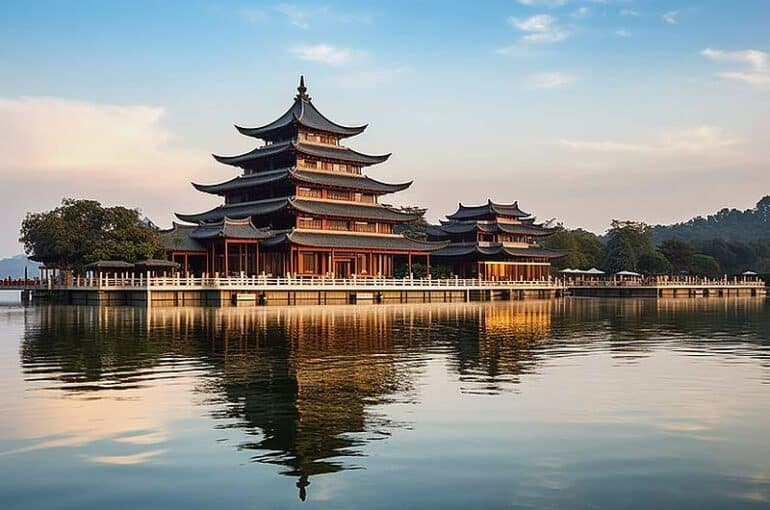Pioneer of sauna comes from Mongolia
Sauna culture in China. The origin of sauna is not in Finland, but in Mongolia. So it’s no wonder that sauna culture is highly valued in China. And public bathhouses also have a long tradition. Especially in northern China, people like to enjoy various treatments in the steamy rooms of the bathhouse on cold winter days. But how do the customs and traditions there differ from our sauna culture?
Everyone finds the sauna to his taste
Whether completely naked, covered with a towel or even in bathing clothes, separately or mixed: the Chinese do not know any uniform customs for this. However, it can be said that in more rural areas, bathhouses are segregated by gender, while in big cities, mixed bathhouses can also be found. In China, the sauna is always part of a bathhouse. This means relaxation for the guest on the whole level, because the offer in these houses includes versatile massages, steam baths, rest areas and hot as well as cold water pools.
The public bathhouses were founded by merchants who, on their long journeys, were looking for a way to wash and take care of their bodies. They were also the ones who gave the bathhouse the resonant name “House of fragrant water”. However, the offer was quickly taken advantage of by the local population as well, because only a few families could afford the luxury of having their own bath in the house at that time. The bathhouse developed into a place where people met regularly, communicated and were able to forget their busy everyday lives for a short while.
What does a visit to a Chinese sauna look like?
Even today in China, a visit to a sauna stands for social communication and mental well-being. When you enter the wellness oasis, you are first led to separate changing areas and given towels, a locker key and often a bathrobe. The next step is a shower area, where you are thoroughly scrubbed down before entering the actual bathing area. Here you have a choice of different water pools, high-temperature saunas or massage rooms. Between treatments, you can doze off in the comfortable armchairs of the relaxation rooms. So you can spend half the day in the bathhouse, but it’s worth it. You leave completely relaxed and yet full of energy.
Unfortunately, many public bathhouses have been torn down in recent years, having to make way for modern high-rise buildings. Most families now have their own bath. But this has not diminished the popularity of the sauna. In many hotels and fitness centers, people now have the opportunity to use modern saunas and steam baths.
The use of herbs and plants in the Chinese sauna
The use of herbs and plants in sauna has a long tradition in China, which can be traced back to ancient times. This tradition is based on traditional Chinese medicine (TCM), which uses the effects of herbs and plants to treat diseases and promote well-being.
In Chinese saunas, various herbs and plants are used to achieve certain effects. Among the most popular herbs and plants are:
- Rosemary and eucalyptus: these herbs are used to clear the respiratory tract and promote blood circulation.
- Lavender and Chamomile: These herbs have a calming and relaxing effect.
- Lemon and Orange: These fruits give a pleasant scent to the sauna and have a stimulating effect.
- Ginger and peppermint: These herbs have a warming and stimulating effect.
The herbs and plants are usually placed on hot stones or in the steam room. The hot stones cause the water in the plants to evaporate and release the active ingredients. The steam is then inhaled or absorbed by the skin.
The use of herbs and plants in Chinese sauna is an effective way to promote health and improve well-being. The herbs and plants have a purifying, relaxing and stimulating effect. They can help clear the respiratory system, promote blood circulation, relieve stress and improve sleep.
Eating and drinking in the Chinese sauna
Unlike Western sauna cultures, where eating and drinking are often taboo, Chinese sauna culture places great emphasis on the culinary experience. Many sauna facilities offer snacks, teas, and soft drinks to keep the body nourished and hydrated after a sauna session. Green tea, ginseng and various fruit juices are especially popular. Some bathhouses even offer entire menus designed to rebalance the body after a sauna session.
The importance of feet in Chinese sauna culture
Foot massages and foot baths are an integral part of sauna and bathhouse culture in China. Chinese medicine places great emphasis on the care and treatment of the feet, as they are considered a mirror of the entire body. Therefore, many saunas offer special foot baths with herbs and essences that can be relaxing, invigorating or healing. Foot massages based on the principles of reflexology are also a common service offered in Chinese bathhouses.

